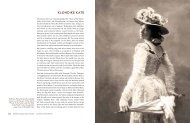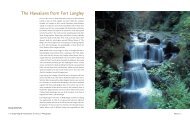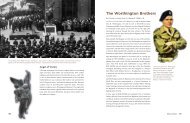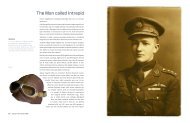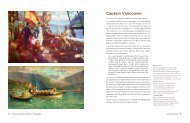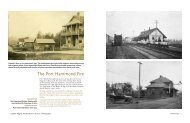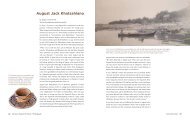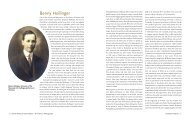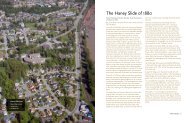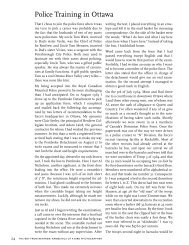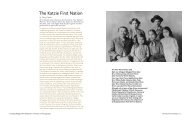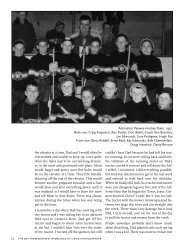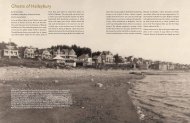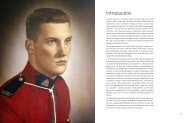Thomas and Ann Haney - Global Bird Photos Collection
Thomas and Ann Haney - Global Bird Photos Collection
Thomas and Ann Haney - Global Bird Photos Collection
You also want an ePaper? Increase the reach of your titles
YUMPU automatically turns print PDFs into web optimized ePapers that Google loves.
This view of Port <strong>Haney</strong> was taken from the Fraser River looking up Ontario Street (now<br />
224th Street). The steamer is tied up at the wharf in front of the Charlton General Store. At<br />
the extreme left is the Carter Store <strong>and</strong> directly behind it is the Municipal Hall. At the right<br />
rear is <strong>Haney</strong> House. At the extreme right are the Temple F. Sinclair Ice Works.<br />
<strong>Thomas</strong> <strong>and</strong> <strong>Ann</strong> <strong>Haney</strong><br />
<strong>Thomas</strong> <strong>Haney</strong>, the man for whom Port <strong>Haney</strong> was named, came out<br />
to British Columbia in 1876 with his father-in-law Daniel Callaghan<br />
<strong>and</strong> brothers-in-law Daniel Jr. <strong>and</strong> Jerry, to seek a new life in the<br />
west. The first eight years of <strong>Thomas</strong> <strong>Haney</strong>’s life had been spent in<br />
Northern Cape Breton Isl<strong>and</strong>. He was the eldest of seven children<br />
born to Bridget <strong>and</strong> Dennis <strong>Haney</strong>. When tragedy truck in 1849 <strong>and</strong><br />
<strong>Thomas</strong>’s father was drowned, the family moved onto a farm near<br />
Paris, Ontario.<br />
When Tom was 14 or 15 years of age, he quit school to learn the<br />
trade of brick making so he could contribute to the family income.<br />
Sometime later his brothers also got into the brick making trade,<br />
<strong>and</strong> by 1871 the brothers had established a brickyard in Paris. In<br />
1873 <strong>Thomas</strong> <strong>Haney</strong> married <strong>Ann</strong> Callaghan at the Sacred Heart<br />
Church in Paris. The year 1875 brought both sorrow <strong>and</strong> joy to the<br />
young couple. In February <strong>Ann</strong>’s mother died. A few months later<br />
<strong>Ann</strong> <strong>and</strong> Tom’s first child, Mary Florence, was born. The death of<br />
Mary Callaghan created a void in the lives of her husb<strong>and</strong> <strong>and</strong> sons,<br />
<strong>and</strong> lured by the news of great opportunities in the gold fields of<br />
California, they decided to pull up stakes <strong>and</strong> go west. It was decided<br />
that Daniel Callaghan with sons Daniel <strong>and</strong> Jerry, together with<br />
<strong>Thomas</strong> <strong>Haney</strong>, would take the train to California to seek a better<br />
life in the frontier. <strong>Ann</strong> <strong>and</strong> the baby would come out later under the<br />
protection of her brother John.<br />
Thus in 1876 the men left by train from Paris, travelling by Union<br />
Pacific to California. They discovered that they were much too late to<br />
benefit from the California gold rush. They worked for a short time<br />
in Sacramento before taking a boat north to eventually reach New<br />
Westminster.<br />
They took a river steamer up the Fraser River to scout out locations<br />
to establish homesteads. <strong>Thomas</strong> found good deposits of clay on the<br />
north side of the river opposite the first Fort Langley. He purchased<br />
the James Wickwire estate for $1000, while the Callaghan family<br />
purchased l<strong>and</strong> from the huge Emmeline Mohun property in Port<br />
Hammond. <strong>Thomas</strong> then sent for his wife <strong>and</strong> daughter. They<br />
travelled to San Francisco, then to New Westminster by boat, <strong>and</strong><br />
then completed the final portion of their journey up the Fraser River<br />
on John Irving’s steamer Reliance. At first the family lived in the<br />
ab<strong>and</strong>oned manse of the St. John the Divine Anglican Church at<br />
<strong>Haney</strong>’s founders <strong>Ann</strong><br />
<strong>and</strong> <strong>Thomas</strong> <strong>Haney</strong>.<br />
126 | Maple Ridge & Pitt Meadows: A History in Photographs<br />
Port <strong>Haney</strong> | 127
steamers that plied up <strong>and</strong> down the river from New<br />
Westminster to Chilliwack <strong>and</strong> sometimes as far as Yale.<br />
The area came to be known as <strong>Haney</strong>’s L<strong>and</strong>ing.<br />
<strong>Thomas</strong> soon began to take an active interest in civic<br />
affairs <strong>and</strong> in 1877 was elected as a councillor for the<br />
District of Maple Ridge. He also acted as the district’s<br />
assessor.<br />
<strong>Ann</strong> <strong>and</strong> Tom were well known for their generosity<br />
<strong>and</strong> hospitality, <strong>and</strong> since they were staunch Roman<br />
Catholics they always looked forward to a visit from a<br />
priest from St. Mary’s Mission, some 15 miles upriver.<br />
The priest from the Mission usually arrived on a<br />
Saturday, returning the following Monday. A room in<br />
the <strong>Haney</strong> home was set aside for this honoured visitor<br />
<strong>and</strong> was referred to as the “Priest’s Room.” One event<br />
of the early years that <strong>Ann</strong> <strong>Haney</strong> well remembered<br />
occurred early in February 1880. Shortly after two<br />
o’clock in the afternoon the <strong>Haney</strong> family was startled<br />
by a rumbling sound that seemed to come from the<br />
river. They rushed outside <strong>and</strong> were horrified to see a<br />
large part of the south bank of the W. Justus Howison<br />
160-acre farm slide into the Fraser River. The slide was<br />
so large that it temporarily blocked the flow of the river<br />
causing a backwash that flooded any low-lying l<strong>and</strong><br />
both up <strong>and</strong> down stream. William Edge was clearing<br />
l<strong>and</strong> on the Langley side of the river <strong>and</strong> was struck by<br />
some debris <strong>and</strong> died from his injuries.<br />
At the time of the <strong>Haney</strong> Slide, the Victoria Daily Colonist<br />
reported: “The rush of l<strong>and</strong> into the river caused the<br />
water to rise nearly twenty feet to the top of the Howison<br />
wharf, on the north side of the river <strong>and</strong>, also high at<br />
the brick yard of Mr. <strong>Haney</strong>, a little above on the same<br />
side….”<br />
While working at clearing his l<strong>and</strong>, <strong>Thomas</strong> fulfilled<br />
his dream <strong>and</strong> established a brickyard. He operated his<br />
brickyard business, the first in Port <strong>Haney</strong>, for eleven<br />
years. The site was on the north side of River Road just<br />
below their home, which was an ideal location to get his<br />
bricks to market by the paddle-wheelers plying up <strong>and</strong><br />
down the river. Many of the chimneys in Port <strong>Haney</strong><br />
This view of Port <strong>Haney</strong> was taken before 1910. The large white building in the left<br />
foreground is the Raymond L. Carter General Store. The white house with the four large<br />
windows is the Robert Henry Beckett residence. The first St. Patrick’s Roman Catholic<br />
Church, with two visible windows, is on the hill behind the CPR waiting room.<br />
<strong>Thomas</strong> <strong>Haney</strong>’s map subdividing<br />
his property. The map clearly shows<br />
the boundaries of his property for<br />
Lot 398, Group 1 – Howison Street<br />
to the west, Front Street to the<br />
south <strong>and</strong> river, Hinch Road to the<br />
east, <strong>and</strong> North Street to the north.<br />
Derby. Mrs. <strong>Haney</strong> was shocked to discover that pranksters had left<br />
a human skull on the pulpit. <strong>Ann</strong> <strong>and</strong> Tom decided to build the<br />
family home on the brow of a hill that overlooked the river. Daniel<br />
Callaghan Jr. <strong>and</strong> Samuel Edge built the home in 1877 with the final<br />
moving-in taking place in late 1877 or early 1878. Tom would row<br />
across the river each day to help them with the work. The lumber<br />
for the home came from New Westminster since there were no saw<br />
mills in the district.<br />
As the homestead l<strong>and</strong> was cleared, the trees were hauled to the<br />
riverbank where they were cut up into cordwood for sale to the<br />
128 | Maple Ridge & Pitt Meadows: A History in Photographs<br />
Port <strong>Haney</strong> | 129
were made from brick from <strong>Thomas</strong>’s brickyard. Initially<br />
he hired only a few employees but after the completion<br />
of the CPR he took on a number of Chinese. They lived<br />
in shacks on the brickyard property <strong>and</strong> worked at<br />
digging the clay <strong>and</strong> moving the finished bricks to the<br />
wharf. Cordwood was used to fire the kilns in the brickmaking<br />
process.<br />
<strong>and</strong> subdivided part of his property near the river. Some<br />
of the street names were chosen for his townsite because<br />
of an association with the <strong>Haney</strong> family. Ontario Street<br />
ran north from the river past <strong>Haney</strong> House; other streets<br />
were St. <strong>Ann</strong>e Street, <strong>Thomas</strong> Street, <strong>Haney</strong> Street, <strong>and</strong><br />
Callighan Street. This last street name was meant to be<br />
Callaghan Street but the error was never corrected.<br />
By the early 1880s many western settlements were<br />
speculating that the CPR line might go through their<br />
properties. <strong>Thomas</strong> hoped that the route would follow<br />
the Fraser River despite the fact that the stability of the<br />
riverbank was questionable due to the recent l<strong>and</strong>slide.<br />
Apparently an all-night debate took place at <strong>Haney</strong> House<br />
to make a final decision of just which route the rail line<br />
would follow, <strong>and</strong> in the end everyone agreed that the<br />
track would follow, along the Fraser River throughout<br />
the district of Maple Ridge. Andrew Onderdonk, the<br />
master contractor for the Pacific section of the railway,<br />
was present at the meeting, as were various engineers<br />
<strong>and</strong> railway officials. Included in the group was<br />
Michael J. <strong>Haney</strong> (no relation to <strong>Thomas</strong>), who was the<br />
construction foreman for much of the BC section of the<br />
CPR.<br />
This was a very exciting time for the <strong>Haney</strong> family, for<br />
they could watch the preparation of the right-of-way for<br />
the laying of steel from their front porch. For a time<br />
<strong>Thomas</strong> worked as a construction foreman as the railway<br />
was built through the district. One day while work was<br />
in progress along the line a chimney fire occurred<br />
at <strong>Haney</strong> House but was quickly put out by railroad<br />
workers, resulting in very little damage. Stories were<br />
told of the time when a CPR paymaster stayed overnight<br />
at <strong>Haney</strong> House on his way up the line. He slept in a<br />
bedroom upstairs, locking the door <strong>and</strong> sleeping with<br />
a loaded shotgun by his side. It was reported that when<br />
one of the first passenger trains came through, <strong>Ann</strong><br />
<strong>Haney</strong> was invited to ride as far as Port Hammond. She<br />
opted to decline the kind offer.<br />
The early 1880s saw many changes as more <strong>and</strong> more<br />
settlers arrived in the district. <strong>Thomas</strong> <strong>Haney</strong> surveyed<br />
In many ways the Fraser River was beginning to lose its<br />
importance as a means of travel. That change became<br />
more definite with the completion of the railway in<br />
1885, even though the river steamers continued regular<br />
schedules for a number of years.<br />
When planning the townsite <strong>Thomas</strong> decided that a<br />
Roman Catholic church should be built on his property.<br />
He donated the l<strong>and</strong> for the building that was constructed<br />
by volunteer labourers <strong>and</strong> with material paid for by<br />
donation. <strong>Ann</strong> <strong>Haney</strong> recorded all donations both<br />
small <strong>and</strong> large in a little black book. Among those who<br />
contributed were Andrew Onderdonk, Michael J. <strong>Haney</strong>,<br />
<strong>and</strong> some of the labourers involved in the building of<br />
the CPR. The men built the church on a small knoll just<br />
southeast of the <strong>Haney</strong> home. The missionaries gave<br />
<strong>Thomas</strong> the privilege of naming the little church <strong>and</strong> he<br />
choose to honour St. Patrick, who was the patron saint<br />
of both <strong>Ann</strong>’s <strong>and</strong> his own ancestors. The church was<br />
dedicated in 1883 <strong>and</strong> served the growing community<br />
until 1926.<br />
<strong>Thomas</strong> <strong>Haney</strong> was generous toward other community<br />
projects <strong>and</strong> donated l<strong>and</strong> for the first municipal hall,<br />
which was built on Callighan Street. He also provided<br />
the l<strong>and</strong> for St. Andrew’s Presbyterian Church. In<br />
addition he set aside an area for community recreation.<br />
With the coming of the railway a small community<br />
sprang up near the wharf <strong>and</strong> the CPR train station,<br />
with newcomers establishing several stores on Front<br />
Street between Fraser <strong>and</strong> Ontario Streets. No doubt<br />
<strong>Thomas</strong> <strong>Haney</strong> felt great pride as he watched each step<br />
of progress in the town that he had founded.<br />
The passing years saw an increase in the <strong>Haney</strong> family. J.<br />
Frank was born in 1877, Daniel T. in 1879, <strong>Ann</strong> Beatrice, nicknamed<br />
‘<strong>Bird</strong>ie’ in 1881, Elizabeth or ‘Lizzie’ in 1883, <strong>and</strong> M. Maud in 1886.<br />
Just after Maud’s birth, Mary, the eldest daughter, became seriously<br />
ill with diphtheria. Although the family made every effort to save<br />
her, she died in 1886. Since there was no Roman Catholic cemetery<br />
in Port <strong>Haney</strong>, Mary’s pallbearers loaded the white coffin into a<br />
canoe <strong>and</strong> paddled upriver to St. Mary’s Mission <strong>and</strong> there carried<br />
the coffin up the hill to the Order of Mary’s Immaculate Cemetery<br />
on the mission grounds. It was a difficult time for the couple <strong>and</strong><br />
their young family.<br />
After a few years <strong>Thomas</strong> sold the brickyard business to establish<br />
a livery stable on <strong>Haney</strong> Street. He also involved himself in other<br />
pursuits <strong>and</strong> on one occasion purchased a hotel on Ontario Street<br />
with his brother-in-law Daniel Callaghan. Unfortunately, this<br />
enterprise came to a sudden end when Daniel, acting as bartender,<br />
sold a bottle of gin to a minor. They learned too late that they had<br />
been set up. The Women’s Christian Temperance Union had sent in<br />
the youth to purchase the liquor.<br />
The <strong>Haney</strong> family poses in front<br />
of their home, 1902. Built in<br />
1876-77, <strong>Haney</strong> House has been<br />
designated a heritage building.<br />
Left to right: Daniel, <strong>Bird</strong>ie, Lizzie,<br />
Maud, parents <strong>Ann</strong> <strong>and</strong> <strong>Thomas</strong>.<br />
130 | Maple Ridge & Pitt Meadows: A History in Photographs<br />
Port <strong>Haney</strong> | 131
<strong>Haney</strong> House, 2008.<br />
By 1895 changes were taking place in the family unit. Sons Frank <strong>and</strong><br />
Daniel had both completed school. Frank took a course in telegraphy<br />
<strong>and</strong> soon started work as an operator, first in Nanaimo, <strong>and</strong> then<br />
later in Laggan (Lake Louise). <strong>Bird</strong>ie completed her schooling <strong>and</strong><br />
planned to become a teacher. Lizzie <strong>and</strong> Maud still attended Lillooet<br />
School, which was located at the corner of Dewdney Trunk Road<br />
<strong>and</strong> Lillooet (later 14th Avenue <strong>and</strong> still later 232nd Street). As the<br />
new century began it became apparent that the town of Port <strong>Haney</strong><br />
would continue to grow. The business district on Front Street began<br />
to exp<strong>and</strong> up the hill on Ontario Street. <strong>Thomas</strong>, along with his<br />
son Daniel, decided to turn their attention to another project. In the<br />
early years Port <strong>Haney</strong> residents often obtained water from wells,<br />
but this source was often unreliable as warm weather or a lack of<br />
snow in the winter lowered the water table. <strong>Thomas</strong> located springs<br />
on his property on the hillside near the slide of 1880 <strong>and</strong> with his<br />
son’s help set up a water system supplying clients with wooden pipes.<br />
Members of the <strong>Haney</strong> family maintained that system until 1941.<br />
In 1909 <strong>Thomas</strong> attended a family reunion held at the home of<br />
his brother in Princeton, Ontario. He crossed the continent by rail<br />
<strong>and</strong> was able to see first-h<strong>and</strong> the engineering feats of the CPR<br />
officials in getting through the Fraser Canyon, the Selkirk <strong>and</strong><br />
Rocky Mountains. At Revelstoke <strong>Thomas</strong> was able to have a brief<br />
meeting with son Frank, who was by then a train dispatcher. Also,<br />
his daughter Lizzie had been employed for a short time at Glacier<br />
House, the tourist hotel built by the CPR in the Selkirk Mountains.<br />
Daughter Maud married Alex Morrison, the son of an ex-HBC<br />
employee at Fort Langley, <strong>and</strong> settled down on a farm adjacent to<br />
the Callaghan Ranch. It was during this period that <strong>Bird</strong>ie became<br />
ill with tuberculosis. Her doctor recommended that she be treated at<br />
the sanatorium at Tranquille, near Kamloops, because of the dryer<br />
climate. When her condition failed to improve there, she returned<br />
home. The upper porch that opened from <strong>Bird</strong>ie’s bedroom was<br />
screened in to provide a sleeping area when weather permitted, but<br />
although her family made every effort to prolong her life, <strong>Bird</strong>ie<br />
died in 1912.<br />
By now <strong>Thomas</strong> was in his seventies <strong>and</strong> was himself beginning<br />
to slow down. He died in 1916. Most of the community gathered to<br />
honour the town’s founder. Businesses <strong>and</strong> schools closed, <strong>and</strong> the<br />
church was so crowded that many mourners had to st<strong>and</strong> outside<br />
during the service. <strong>Thomas</strong> was buried in Maple Ridge cemetery<br />
beside his daughter <strong>Bird</strong>ie. His grave marker reads: “A man of vision,<br />
kindness <strong>and</strong> generosity.” <strong>Ann</strong> <strong>Haney</strong> continued to live in the family<br />
home with her daughter Lizzie. When the daughter married James<br />
Hawley in 1917, <strong>Ann</strong> lived alone in the house on the hill. Lizzie <strong>and</strong><br />
Jim decided to make their home with her for her final years. <strong>Ann</strong><br />
<strong>Haney</strong> passed away in 1931 at the age of 84. Daniel <strong>Haney</strong>’s tragic<br />
death in 1927 was a heavy blow to <strong>Ann</strong> <strong>and</strong> all the family. He had<br />
taken a steamer into New Westminster to get a shotgun fixed so he<br />
could enjoy a few days pheasant hunting with his brother Frank.<br />
His lifeless body was found under a dock in New Westminster. The<br />
official cause of death was listed as drowning, but many members<br />
of the family were convinced that foul play was involved. With Dan’s<br />
passing, the water works was taken over by Colin Genge, his brotherin-law.<br />
Genge was married to Maud <strong>Haney</strong>.<br />
Alcohol <strong>and</strong> Worms<br />
Tom <strong>Haney</strong>’s namesake gr<strong>and</strong>son<br />
<strong>Thomas</strong> John J. <strong>Haney</strong> had a story<br />
about his jokester gr<strong>and</strong>father:<br />
A minister came into town <strong>and</strong> wanted<br />
to go around <strong>and</strong> preach to the people<br />
of Pitt Meadows about the evils of<br />
alcohol. He gave a demonstration <strong>and</strong><br />
put a worm in a bottle of whiskey <strong>and</strong><br />
of course the worm died. Tom spoke<br />
up <strong>and</strong> caused a bit of a commotion by<br />
saying, “I’ve got worms!”<br />
Following Pages<br />
Docksteader’s General Store<br />
<strong>and</strong> Post Office, circa 1895.<br />
The Docksteader General Store <strong>and</strong><br />
Post Office was located on the wharf<br />
where the riverboat traffic tied up during<br />
the years of steamer transportation<br />
on the Fraser River. This image was<br />
taken from the wharf toward the<br />
northeast <strong>and</strong> clearly shows the Roman<br />
Catholic church in the middle right.<br />
The man in the carriage is storeowner<br />
Arthur Docksteader, the man in the<br />
doorway with the white shirt <strong>and</strong> vest<br />
is Mr. Baltham, <strong>and</strong> the man seated<br />
on the horse is Tom Marshall.<br />
On the wall immediately behind<br />
Docksteader’s head is a circular<br />
advertisement for “Burdock Blood<br />
Bitters.” A 1914 report of the<br />
Connecticut Agricultural Experimental<br />
Station reported: “This ‘safe’ remedy<br />
contains over 19 % of alcohol, with<br />
only 4.85 % of solids (nearly half of<br />
which is sugar), <strong>and</strong> alkaloids possibly<br />
derived from hydrastis. The amount of<br />
vegetable extractives is small, certainly<br />
not enough to give the results claimed.<br />
From the composition reported <strong>and</strong><br />
also from the name of the stuff, it<br />
would appear to be one of the nostrums<br />
of the old ‘blood purifier’ type. Such<br />
products, as you know, are useless,<br />
as they do not purify the blood.”<br />
132 | Maple Ridge & Pitt Meadows: A History in Photographs<br />
Port <strong>Haney</strong> | 133
134 | Maple Ridge & Pitt Meadows: A History in Photographs<br />
Port <strong>Haney</strong> | 135



